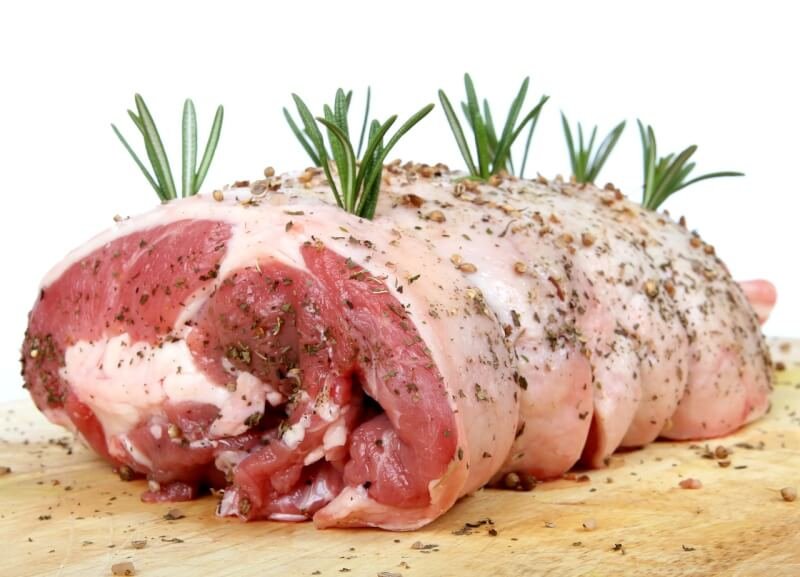Do you ever find yourself standing in front of the meat aisle, unsure of which cut to choose and if it’s fresh? It’s a common dilemma for many of us, but fear not, because we’re here to help you unravel the mystery of fresh meat. In this article, we’ll share some tips and tricks on how you can easily determine the freshness of meat, ensuring that your next culinary adventure starts off on the right foot. So, let’s get started and put those meat-buying anxieties to rest!

Visual Inspection
When it comes to checking the freshness of meat, the first step is to conduct a visual inspection. This involves carefully examining the meat for any signs of spoilage or damage. There are several key factors to consider during this process:
Color
One of the easiest ways to determine the freshness of meat is by examining its color. Fresh meat typically has a vibrant and consistent color, while spoiled meat may appear dull or discolored. For example, beef should have a bright red hue, while pork and poultry should have a rosy or pink color. Any signs of greenish or yellowish discoloration may indicate spoilage.
Texture
Another important aspect to consider during visual inspection is the texture of the meat. Fresh meat should feel firm and springy to the touch, indicating that it is still tender and of good quality. On the other hand, meat that feels mushy or slimy could be a sign of spoilage and should be avoided. Additionally, be on the lookout for any excessive toughness or dryness, as these could also be indications of poor quality.
Odor
The sense of smell is a powerful tool when it comes to determining the freshness of meat. Fresh meat should have a pleasant and mild odor, often described as a “fresh meat smell.” This aroma is a result of the natural compounds present in meat. However, if you detect any off or strong odors, such as a sour or rotten smell, it is best to avoid consuming the meat, as it may be spoiled.
Packaging
Lastly, it is important to carefully inspect the packaging of the meat. Look for any signs of damage or tampering, such as torn or punctured packaging. If the meat is vacuum-sealed, ensure that there are no air pockets or signs of leakage. Proper packaging helps to maintain the freshness and quality of the meat, so it is crucial to choose intact packaging.
Checking Expiration Dates
In addition to conducting a visual inspection, it is vital to check the expiration dates on meat packaging. These dates provide valuable information on the freshness and shelf life of the product. There are two primary types of expiration dates to be aware of:
Sell-By Date
The sell-by date indicates the last day that the product should be sold by the retailer. This date is primarily for the store’s reference and ensures that customers have adequate time to consume the meat at home before it potentially starts to deteriorate. However, it is important to note that the meat can still be safe to consume for a few days after the sell-by date if it has been stored properly.
Use-By Date
The use-by date is the date recommended by the manufacturer for consuming the meat at its peak quality. After this date, the quality of the meat may start to decline, and there is a higher risk of spoilage. It is generally advised to consume the meat before the use-by date for the best taste and freshness.
It is crucial to check the expiration date before purchasing or consuming meat to ensure that it is still within its recommended freshness period. However, it is important to remember that these dates are just guidelines, and the meat’s actual freshness may vary based on storage conditions and handling.
Label Information
The label on meat products contains essential information that can assist in determining freshness and quality. When inspecting meat, be sure to check for the following details:
Grade
The grade of the meat refers to its quality and tenderness. Different countries may have different grading systems, but generally, higher-grade meat indicates better quality. For example, in the United States, beef is often graded as Prime, Choice, or Select, with Prime being the highest quality. Consider the grade of the meat you are purchasing, as it can be an indication of freshness and tenderness.
Source
Knowing the source of the meat can provide valuable insights into its quality and safety. Look for information on where the meat was raised or produced. If possible, opt for meat that is locally sourced or from trusted suppliers known for their high standards. This can help ensure that the meat is fresh and produced under the appropriate regulations and guidelines.
Certification
Certifications and labels from reputable organizations can provide further assurance of the meat’s quality. Look for certifications such as organic, grass-fed, or humane. These labels indicate that the meat has met specific standards and has undergone rigorous inspections. While not always necessary, certifications can be an added reassurance when selecting fresh meat.
Storage Instructions
The label also often contains storage instructions that are crucial for maintaining the freshness of the meat. Follow these instructions carefully to ensure that the meat stays in optimal condition. Proper storage, such as refrigeration or freezing at the recommended temperatures, can extend the shelf life and maintain the quality of the meat.
Physical Appearance
Apart from the initial visual inspection, there are specific physical characteristics of meat that can provide further insights into its freshness. Pay attention to the following aspects:
Blood Spots
Blood spots, also known as bruising or petechiae, can occasionally be found in meat. These small spots are caused by broken blood vessels and are a normal occurrence in some cuts. While they are generally harmless, an excessive amount of blood spots or large areas of discoloration may indicate mishandling or poor quality.
Discoloration
Discoloration can be an important indicator of meat freshness. Fresh meat should have a consistent color throughout, with no notable discoloration or dark spots. If you notice any areas of green, brown, or gray discoloration, it may be a sign of spoilage or bacterial growth. Discolored meat should be avoided to minimize the risk of foodborne illness.
Freezer Burn
When meat is improperly stored in the freezer, it can develop freezer burn. Freezer burn occurs when moisture is lost from the meat, leading to dry, discolored patches. Visually inspect the meat for any signs of freezer burn, such as white or grayish patches on the surface. While freezer burn may not make the meat unsafe to consume, it can affect the taste and texture, so it is best to avoid purchasing or consuming freezer-burned meat.
Mold
Mold growth on meat is a clear indication of spoilage. Check the surface of the meat for any signs of fuzzy or powdery mold. Even small amounts of mold can indicate potential contamination or unsanitary conditions. Moldy meat should never be consumed, as it can cause food poisoning and other health issues.
Water Content
Although it may not be directly visible, excessive water content in meat can be indicative of poor quality. Waterlogged meat can result from improper storage or processing and may lead to a bland or washed-out taste. To assess the water content, squeeze the meat gently to check for any excessive moisture. Fresh meat should not feel overly wet or soggy.
Touch and Feel
In addition to visual cues, the sense of touch can provide useful information about meat freshness. Pay attention to the following factors:
Firmness
Fresh meat should have a firm and slightly springy texture when touched. Gently press your finger against the meat to assess its firmness. If the meat feels mushy, soft, or overly tender, it could be a sign of spoilage. On the other hand, if the meat feels excessively hard or tough, it may be an indication of poor quality or improper handling.
Stickiness
Stickiness is another factor to consider when assessing meat freshness. Touch the surface of the meat and observe if it feels sticky or tacky. Fresh meat should not have a sticky texture. If you notice any stickiness, it may be a sign of bacterial growth or excessive moisture, indicating compromised freshness.
Sliminess
Sliminess is a clear indication of meat spoilage. When meat starts to spoil, it can develop a slimy or slippery texture. Avoid meat that feels slimy to the touch, as it can harbor harmful bacteria and pose health risks. Fresh meat should have a clean and dry surface.
Smell Test
A significant aspect of determining meat freshness is utilizing your sense of smell. The odors emitted by meat can reveal a lot about its condition. Consider the following factors:
Fresh Meat Smell
Fresh meat should have a pleasant and mild odor commonly referred to as the “fresh meat smell.” This aroma is a result of the natural compounds present in meat. When inspecting meat, take a moment to take a gentle sniff and assess its smell. If the meat exhibits a clean, slightly sweet, and meaty scent, it is likely fresh. Trust your sense of smell, as it can often detect subtle changes or signs of spoilage.
Off Odors
Conversely, off or unpleasant odors can be an indication of meat spoilage. If you detect any strong, sour, or rotten smells, it is best to discard the meat immediately. Foul odors can signify bacterial growth or decomposition, making the meat unsafe to consume. If in doubt, always trust your nose and err on the side of caution.
Packaging
The packaging of meat plays a crucial role in preserving its freshness and quality. Take the time to inspect the packaging for the following attributes:
Vacuum Sealed
Vacuum-sealed packaging is commonly used for preserving the freshness of meat. It removes air from around the meat, reducing the risk of spoilage and freezer burn. Check the packaging for any signs of air pockets or compromised seals. If the vacuum-sealed packaging appears inflated or has noticeable gaps, it may indicate that the seal has been compromised, potentially affecting the meat’s freshness.
Modified Atmosphere Packaging
Modified atmosphere packaging (MAP) is another technique used to extend the shelf life of meat. It involves replacing the air in the packaging with a mixture of gases that inhibit bacterial growth. Inspect MAP packaging for any signs of damage or leakage. If the packaging appears bloated or the seal is broken, it is best to avoid purchasing the meat, as it may have been exposed to the air, compromising its freshness.
Leakage
Leakage is a red flag when it comes to meat packaging. Carefully examine the package for any signs of liquid or moisture seeping out. Excessive leakage can indicate potential contamination or spoilage. Choosing meat with intact and dry packaging is essential to ensure its freshness and safety.
Seals
Check the integrity of the packaging seals to ensure that they are intact and secure. Run your fingers along the seams and edges of the packaging to ensure there are no rips, tears, or openings. A compromised seal can lead to microbial contamination and spoilage. It is crucial to select meat with packaging that is properly sealed to maintain its freshness and quality.
Sell-By Date vs. Use-By Date
Understanding the difference between sell-by dates and use-by dates is vital when assessing meat freshness. Here’s what you need to know:
Sell-By Date
The sell-by date is primarily for retailers, indicating the last day the product should be sold. It ensures that customers have ample time to consume the meat at home before it potentially starts to deteriorate. However, the meat can still be safe to consume for a few days after the sell-by date if it has been stored properly.
Use-By Date
The use-by date is the manufacturer’s recommendation for consuming the meat at its peak quality. After this date, the quality of the meat may begin to decline, and there is a higher risk of spoilage. It is generally advised to consume the meat before the use-by date for the best taste and freshness.
While sell-by and use-by dates are helpful guidelines, it is important to remember that the actual freshness of meat may vary based on various factors, such as storage conditions and handling practices. Use these dates as a reference but rely on your senses and the visual indicators mentioned earlier to make an informed decision about meat freshness.
Effect of Storage
Proper storage is crucial in maintaining the freshness and safety of meat. Several factors can influence the meat’s longevity and quality:
Time
The length of time meat has been stored can significantly impact its freshness. The longer meat is stored, the greater the chance of spoilage or degradation in quality. If the meat has been in the refrigerator or freezer for an extended period, it is essential to pay extra attention to its visual appearance, odor, and texture to ensure it is still fresh.
Temperature
Temperature plays a critical role in slowing down the growth of bacteria in meat. Storing meat at the appropriate temperature helps maintain its quality and safety. Refrigerate fresh meat at or below 40°F (4°C) to slow bacterial growth. If you plan to store the meat for an extended period or if it won’t be consumed within a few days, consider freezing it at or below 0°F (-18°C). Ensure your refrigerator and freezer are set to the correct temperatures to preserve meat freshness effectively.
Contamination
Avoiding cross-contamination is essential to prevent the growth of harmful bacteria. Store raw meat away from ready-to-eat foods, such as fruits and vegetables, to minimize the risk of foodborne illnesses. Consider placing the meat on a separate tray or in a sealed container to prevent any potential drips or leaks from contaminating other foods in the refrigerator. Additionally, proper handling and hygiene practices, such as washing hands and utensils thoroughly, can further minimize the risk of contamination.
Seeking Professional Guidance
If you are unsure about the freshness or quality of meat, it is always advisable to seek professional guidance. Two valuable resources you can turn to are butchers and food inspectors:
Butcher
Butchers are highly experienced in handling and assessing meat. They possess in-depth knowledge of various cuts and can provide guidance on freshness, cooking techniques, and optimal storage conditions. Consult your local butcher when you have specific questions or concerns about meat, as they can offer expert advice tailored to your needs.
Food Inspector
Food inspectors play a vital role in ensuring the safety and quality of meat in commercial establishments. If you suspect a particular meat product may be unsafe or if you have concerns about the handling or labeling of the meat, you can contact your local food inspection agency. They have the expertise and authority to investigate potential issues and provide professional guidance.
In situations where you are uncertain about the freshness of meat or have specific questions regarding its quality, reaching out to professionals can help alleviate concerns and ensure that you make informed decisions.
In conclusion, assessing the freshness of meat requires a combination of visual inspection, checking expiration dates, evaluating label information, observing physical appearance, using touch and feel, conducting the smell test, examining packaging, understanding sell-by dates and use-by dates, considering the effect of storage, and seeking professional guidance when needed. By following these comprehensive guidelines, you can confidently select fresh, high-quality meat for your meals while minimizing the risk of consuming spoiled or unsafe products.


